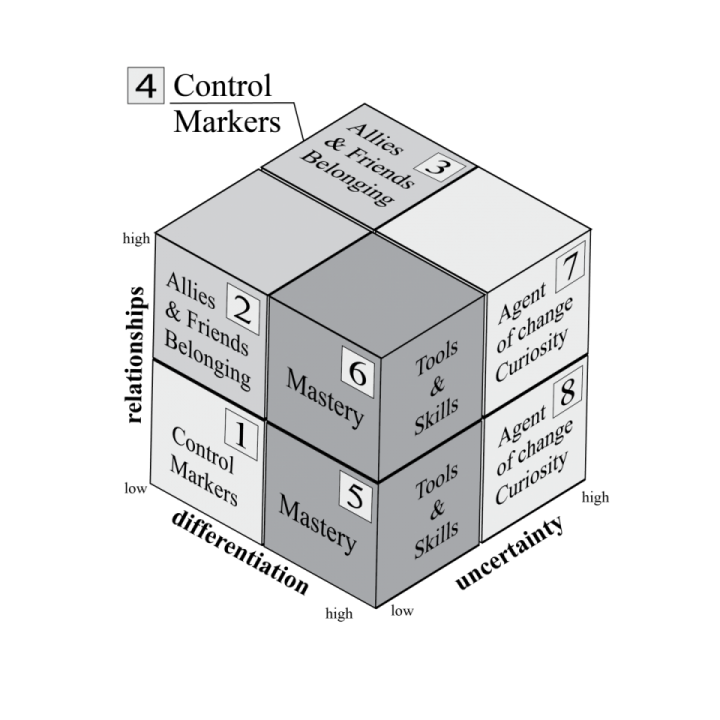Whether we like to think about the following statement this way or not, there’s no way of getting around it. While I anticipate some eye-rolling — and, frankly, sometimes react that way myself — buyers of professional services are on a journey.
For example, McKinsey has this model they call Consumer Decision Journey (CDJ). In essence, it fits B2B and B2C clients of professional services as much as pedestrian consumers. Initially, their model proposed a linear progression. Nowadays, it’s more of a spiral (or circular).
If you’re not a fan of the term journey, you can think of your clients getting from point A to point B. You may think of it in terms of Jobs-to-be-Done (JTBD). You may also think of this as changing the current state to a preferable future state. Whichever way you think about your clients: looking, finding, learning, contemplating, considering, evaluating, selecting, negotiating, buying and suffering away during your service provision, this journey is a process: a pursuit of a valuable goal.
Pursuit of a valued goal
These three words: pursuit, valued, and goal are important. First, value is hard to define, and it is often subjective. Second, goal is much easier to define. However, when the goal isn’t specified properly — which happens quite often — the outcomes can be very frustrating. Third, the pursuit is often more important than attainment.
Knowing that you clients will be pursuing goals that are of value to them, your job, obviously, is to assist them. This is done through service provision. This isn’t (shouldn’t be) a world-shattering secret to anyone: the functional components we include in service offerings are often as important as how we are providing our services.
Turns out, the process of goal pursuit has four (eight) distinct components that are of value to clients. I call these: goal facilitators.
Eight goal facilitators
Grouped into four themes, the eight goal facilitators that assist clients along the way toward a valued goal are:
- Markers of Stability & Markers of Progress
- Tools & Skills
- Allies & Friends
- Agents of Change (Elixir & Perspective)
Some buyers will exhibit behavior that is regulated primarily by sense of Control. Therefore such buyers will (primarily) want to track their progress toward a valued goal, as well as gauge stability of current state(s). Hence, interest in Markers of Progress and Stability. Markers have no direct impact on costs savings, nor do they enhance performance; yet they are valuable in and of themselves.
Second, buyers may encounter opposition and foes, and will require Allies and Friends who will help them cope with opposition and adversity respectively. Hence, interest in Allies & Friends. This is driven by Belonging.
Next, because some buyers are also motivated by Mastery, and they know there will be obstacles, they will require tools — hence, relevant skills — to deal with them. Tools & Skills are the third group of goal facilitators.
Finally, buyers are fully aware of the importance of Exploratory Curiosity because of the potential extreme states of entropy in their organizations: both low and high. While the state of lower entropy is generally preferable, absence of entropy may be pathological.
On the upside, low-entropy firms are very organized and efficient. On the flip side, a firm may get too rigid, inflexible, and tunnel-visioned. Highly ordered systems often find themselves synchronized in efficiently rowing in the wrong direction; at times, toward their doom. That is why the authors of Built to Last encourage firms to “Preserve the core and stimulate progress” (Collins & Porras, 1994, p. 82).
On the other hand, in a high entropy state, while extremely flexible and energetic, the firm may lack coherent direction, become too uncertain, and chaotic. Pointing in random or opposite directions, individual and team efforts may cancel each other out. Too many competing options of equal significance create anxiety among employees despite a seeming cornucopia of opportunities. Hence, buyers of professional services understand the eventual necessity in acquiring services of the Agents of Change (AoC) — either internal or external — who will act as catalysts of transformation.
Such AoC activities will initially introduce additional entropy into the system with a sole purpose to redistribute the probability of desired outcomes in a way conducive of decision making and ensuing action (Hirsh, Mar & Peterson, 2012). In professional organizations, exploration is employed to investigate uncertainty and manage entropy levels. Figure 1 exhibits the mapping of four goal facilitator themes onto four motivational drives.

To provide you with a real world example for the above: if we are selling a bare-bones service of filing tax reports, the buyer is paying for both a deliverable and a Marker. If this service comes with further support such as dispute resolution with the IRS, this service adds the Allies & Friends component. If the service comes with (e.g.) online tools and training, it has the Tools & Skills goal facilitator theme. And when the service is enhanced by extensive analysis, problem definition, consultations, alternative solutions generation, recommendations, and advice, its goal facilitation involves Agent of Change component.
We should acknowledge that buyers will differ in preferable goal facilitator composition. Motivated solely by sense of Control, the buyer will become interested exclusively in purchasing Markers of Stability & Progress; because of its confidence that (1) either there will be no Foes, Obstacles, and need for Agents of change, or (2) they will have internal capacity (tools, skills) to manage any adversity and change. This is often expressed as “Been there, done that” attitude.
Hence, for service providers, to expend resources on goal facilitators and ensuing activities that this particular type of buyer will find worthless makes no sense. For example, bundling basic service offering with mandatory training for a buyer who doesn’t want or need such training will be a waste of seller resources and result in lower profitability.
Learning from an expert organizer
Recently, I have stumbled on a business that can perfectly portrait the aforementioned ideas. KonMari is an international brand, a company, and a consulting practice built around one idea: mastering tidying and organizing. The founder is Marie Kondo who is known as a “tidying expert.”
Having investigated her offerings, I have identified all four goal facilitator themes:
- her shop offers Tools you can buy to organize your home and office (boxes, storage, organizers, accessories, etc.);
- the website offers Skills: tidying courses, folding techniques, planning tips, KonMari Method, etc.;
- Marie herself as well as her fleet of certified consultants act as Agents of Change (for a fee). They promise to “get to the core of the ’life-changing magic’ of the KonMari Method to discover your most fulfilling and joyful life”;
- as Markers of Progress customers are offered charts, check-off lists, workbooks, confidence boosters, “share your tidying trials and triumphs #mykonmari” on IG, etc.;
- Allies facilitation occurs though customer support activities, an opportunity to become one of the certified consultants yourself, hiring consultants to organize your stuff for you, or asking them a question;
- Friends can be found at KonMari’s Reddit channel with 163k followers to help you out, active follower base on other social media channels, too.
The takeaway is unambiguous: you can integrate the same goal facilitators in your practice and service offerings to maximize value creation and capture. In my consulting practice, I include the Figure 1 model in the Service Offering Design module which is part of several advisory solutions and suites.
Reach out if you want to know more about this fascinating topic, and how it can help your professional practice.
References
Collins, J.C. & Porras, J.I. (1994). Built to Last: Successful habits of visionary companies. New York, NY: HarperCollins.
Hirsh, J.B., Mar, R.A. & Peterson, J.B. (2012). Psychological Entropy: A Framework for Understanding Uncertainty-Related Anxiety. Psychological review, Vol.110, No.2, pp. 304–320.
The awezzom question of the day:
Which goal facilitators we haven’t been offering to our clients?

